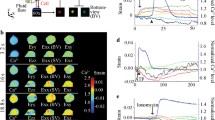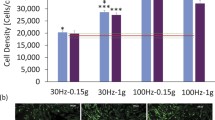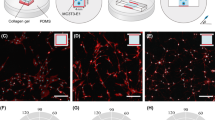Abstract
Osteoblasts respond to shear stress by simultaneously increasing their whole-cell stiffness and up-regulating the cytoskeletal crosslinking protein α-actinin. The stiffness of reconstituted cytoskeletal networks increases following the addition of α-actinin, but the effect of α-actinin on whole-cell mechanical behavior has not been investigated. The hypothesis of this study was that increasing α-actinin in the cytoskeleton would be sufficient to increase whole-cell stiffness. hFOB osteoblasts were transfected with a plasmid for GFP-tagged α-actinin, resulting in a 150% increase in the amount of α-actinin. The GFP-α-actinin fusion protein co-fractionated with the cytoskeleton and co-localized to the same regions of the cytoskeleton as endogenous α-actinin. Whole-cell mechanical behavior was measured by atomic force microscopy using a 25 μm diameter microsphere as an indenter. The whole-cell stiffness of cells over-expressing GFP-α-actinin was 60% higher than cells expressing only endogenous α-actinin (p < 0.002), which was within the range of mechanical behavior observed in osteoblastic cells exposed to 1 and 2 Pa of fluid shear. These results indicate that the up-regulation of α-actinin synthesis in osteoblasts is sufficient to alter the whole-cell mechanical behavior and highlights the potential role of α-actinin to reinforce cells against mechanical loads.






Similar content being viewed by others
References
Bell, P. B., Jr. The application of scanning electron microscopy to the study of the cytoskeleton of cells in culture. Scan. Electron Microsc. 139–157, 1981.
Blanchard A., V. Ohanian, D. Critchley. The structure and function of alpha-actinin. J Muscle Res Cell Motil 10: 280–289, 1989
Broers J. L., E. A. Peeters, H. J. Kuijpers, J. Endert, C. V. Bouten, C. W. Oomens, F. P. Baaijens, F. C. Ramaekers. Decreased mechanical stiffness in lmna-/- cells is caused by defective nucleo-cytoskeletal integrity: Implications for the development of laminopathies. Hum Mol Genet 13: 2567–2580, 2004
Butt D. B., M. Jaschke. Calculation of thermal noise in atomic force microscopy. Nanotechnology 6: 1–6, 1995
Carvalho R. S., J. E. Scott, D. M. Suga, E. H. Yen. Stimulation of signal transduction pathways in osteoblasts by mechanical strain potentiated by parathyroid hormone. J Bone Miner Res 9: 999–1011, 1994
Charras G. T., M. A. Horton. Determination of cellular strains by combined atomic force microscopy and finite element modeling. Biophys J 83: 858–879, 2002
Charras G. T., M. A. Horton. Single cell mechanotransduction and its modulation analyzed by atomic force microscope indentation. Biophys J 82: 2970–2981, 2002
Charras G. T., P. P. Lehenkari, M. A. Horton. Atomic force microscopy can be used to mechanically stimulate osteoblasts and evaluate cellular strain distributions. Ultramicroscopy 86: 85–95, 2001
Costa K. D., F. C. Yin. Analysis of indentation: Implications for measuring mechanical properties with atomic force microscopy. J Biomech Eng 121: 462–471, 1999
Discher D. E., P. Janmey, Y. L. Wang. Tissue cells feel and respond to the stiffness of their substrate. Science 310: 1139–1143, 2005
Edlund M., M. A. Lotano, C. A. Otey. Dynamics of alpha-actinin in focal adhesions and stress fibers visualized with alpha-actinin-green fluorescent protein. Cell Motil Cytoskeleton 48: 190–200, 2001
Forgacs G., S. H. Yook, P. A. Janmey, H. Jeong, C. G. Burd. Role of the cytoskeleton in signaling networks. J Cell Sci 117: 2769–2775, 2004
Fraley T. S., C. B. Pereira, T. C. Tran, C. Singleton, J. A. Greenwood. Phosphoinositide binding regulates alpha-actinin dynamics: Mechanism for modulating cytoskeletal remodeling. J Biol Chem 280: 15479–15482, 2005
Freshney R. I. Culture of animal cells. New York: Wiley-Liss, 2000
Frost H. M. Does bone design intend to minimize fatigue failures? A case for the affirmative. J Bone Miner Metab 18: 278–282, 2000
Gardel M. L., J. H. Shin, F. C. MacKintosh, L. Mahadevan, P. Matsudaira, D. A. Weitz. Elastic behavior of cross-linked and bundled actin networks. Science 304: 1301–1305, 2004
Glogauer M., P. Arora, G. Yao, I. Sokholov, J. Ferrier, C. McCulloch. Calcium ions and tyrosine phosphorylation interact coordinately with actin to regulate cytoprotective responses to stretching. J Cell Sci 110: 11–21, 1997
Goldmann W. H., R. Galneder, M. Ludwig, W. Xu, E. D. Adamson, N. Wang, R. M. Ezzell. Differences in elasticity of vinculin-deficient f9 cells measured by magnetometry and atomic force microscopy. Exp Cell Res 239: 235–242, 1998
Goldmann W. H., D. E. Ingber. Intact vinculin protein is required for control of cell shape, cell mechanics, and rac-dependent lamellipodia formation. Biochem Biophys Res Commun 290: 749–755, 2002
Hartwig J. H., D. J. Kwiatkowski. Actin-binding proteins. Curr Opin Cell Biol 3: 87–97, 1991
Heidemann S. R., D. Wirtz. Towards a regional approach to cell mechanics. Trends Cell Biol 14: 160–166, 2004
Hutter, J. L. and J. Bechhoefer. Calibration of atomic-force microscope tips. Rev. Sci. Instrum. 64:1868–1873, 1993
Ingber D. E. Cellular tensegrity: Defining new rules of biological design that govern the cytoskeleton. J Cell Sci 104: 613–627, 1993
Ingber D. E. Tensegrity ii. How structural networks influence cellular information processing networks. J Cell Sci 116: 1397–1408, 2003
Inoue D., S. Kido, T. Matsumoto. Transcriptional induction of fosb/deltafosb gene by mechanical stress in osteoblasts. J Biol Chem 279: 49795–49803, 2004
Jaasma, M. Osteoblast mechanical behavior and its adaptation to mechanical loading, Ph.D., Berkeley, UC Berkeley, 2004.
Jaasma M. J., W. M. Jackson, T. M. Keaveny. The effects of morphology, confluency, and phenotype on whole-cell mechanical behavior. Ann Biomed Eng 34: 759–768, 2006
Jaasma M. J., W. M. Jackson, T. M. Keaveny. Measurement and characterization of whole-cell mechanical behavior. Ann Biomed Eng 34: 748–758, 2006
Jaasma M. J., W. M. Jackson, R. Y. Tang, T. M. Keaveny. Adaptation of cellular mechanical behavior to mechanical loading for osteoblastic cells. J Biomech 40: 1938–1945, 2007
Jackson, W. M., M. J. Jaasma, and T. M. Keaveny. Human pre-osteoblasts respond to fluid shear by up-regulating alpha-actinin in the cytoskeleton. In: Proceedings of the Biomedical Engineering Society Annual Conference. Baltimore, MD, #1086, 2005.
Janmey P. A. Mechanical properties of cytoskeletal polymers. Curr Opin Cell Biol 3: 4–11, 1991
Janmey P. A., D. A. Weitz. Dealing with mechanics: Mechanisms of force transduction in cells. Trends Biochem Sci 29: 364–370, 2004
Klein-Nulend J., M. H. Helfrich, J. G. Sterck, H. MacPherson, M. Joldersma, S. H. Ralston, C. M. Semeins, E. H. Burger. Nitric oxide response to shear stress by human bone cell cultures is endothelial nitric oxide synthase dependent. Biochem Biophys Res Commun 250: 108–114, 1998
Knothe Tate M. L., U. Knothe, P. Niederer. Experimental elucidation of mechanical load-induced fluid flow and its potential role in bone metabolism and functional adaptation. Am J Med Sci 316: 189–195, 1998
Lee J. S., P. Panorchan, C. M. Hale, S. B. Khatau, T. P. Kole, Y. Tseng, D. Wirtz. Ballistic intracellular nanorheology reveals rock-hard cytoplasmic stiffening response to fluid flow. J Cell Sci 119: 1760–1768, 2006
Lindroth M., P. B. Bell Jr., B. A. Fredriksson, X. D. Liu. Preservation and visualization of molecular structure in detergent-extracted whole mounts of cultured cells. Microsc Res Tech 22: 130–150, 1992
Maciver, S. K. Microfilament organization and actin-binding proteins. In: The Cytoskeleton, edited by J. E. Hesketh and I. F. Pryme. JAI Press Inc., 1995, pp. 1–45.
Mahaffy R. E., C. K. Shih, F. C. MacKintosh, J. Kas. Scanning probe-based frequency-dependent microrheology of polymer gels and biological cells. Phys Rev Lett 85: 880–883, 2000
Malone, A., C. Anderson, P. Tummala, T. Sterns, and C. Jacobs. Are Primary Cillia Mechanosensory Organelles in Bone Cells? Chicago, IL: Trans Orthopaedic Research Society, p. 369, 2006.
McGarry J. G., J. Klein-Nulend, M. G. Mullender, P. J. Prendergast. A comparison of strain and fluid shear stress in stimulating bone cell responses–a computational and experimental study. Faseb J 19: 482–484, 2005
Mukhina S., Y. L. Wang, M. Murata-Hori. Alpha-actinin is required for tightly regulated remodeling of the actin cortical network during cytokinesis. Dev Cell 13: 554–565, 2007
Nauman E. A., R. L. Satcher, T. M. Keaveny, B. P. Halloran, D. D. Bikle. Osteoblasts respond to pulsatile fluid flow with short-term increases in pge(2) but no change in mineralization. J Appl Physiol 90: 1849–1854, 2001
Otey C. A., O. Carpen. Alpha-actinin revisited: A fresh look at an old player. Cell Motil Cytoskeleton 58: 104–111, 2004
Pavalko F. M., N. X. Chen, C. H. Turner, D. B. Burr, S. Atkinson, Y.-F. Hsieh, J. Qiu, R. L. Duncan. Fluid shear-induced mechanical signaling in mc3t3-e1 osteoblasts requires cytoskeleton-integrin interactions. Am J Physiol Cell Physiol 275: C1591–1601, 1998
Pellegrin S., H. Mellor. Actin stress fibres. J Cell Sci 120: 3491–3499, 2007
Pelletier O., E. Pokidysheva, L. S. Hirst, N. Bouxsein, Y. Li, C. R. Safinya. Structure of actin cross-linked with alpha-actinin: A network of bundles. Phys Rev Lett 91: 148102, 2003
Ponik S. M., F. M. Pavalko. Formation of focal adhesions on fibronectin promotes fluid shear stress induction of cox-2 and pge2 release in mc3t3-e1 osteoblasts. J Appl Physiol 97: 135–142, 2004
Rivero F., B. Koppel, B. Peracino, S. Bozzaro, F. Siegert, C. J. Weijer, M. Schleicher, R. Albrecht, A. A. Noegel. The role of the cortical cytoskeleton: F-actin crosslinking proteins protect against osmotic stress, ensure cell size, cell shape and motility, and contribute to phagocytosis and development. J Cell Sci 109 (Pt 11): 2679–2691, 1996
Rotsch C., M. Radmacher. Drug-induced changes of cytoskeletal structure and mechanics in fibroblasts: An atomic force microscopy study. Biophys J 78: 520–535, 2000
Saez A., A. Buguin, P. Silberzan, B. Ladoux. Is the mechanical activity of epithelial cells controlled by deformations or forces? Biophys J 89: L52–54, 2005
Sato M., G. Leimbach, W. H. Schwarz, T. D. Pollard. Mechanical properties of actin. J Biol Chem 260: 8585–8592, 1985
Stossel T. P., J. Condeelis, L. Cooley, J. H. Hartwig, A. Noegel, M. Schleicher, S. S. Shapiro. Filamins as integrators of cell mechanics and signalling. Nat Rev Mol Cell Biol 2: 138–145, 2001
Tseng Y., T. P. Kole, J. S. Lee, E. Fedorov, S. C. Almo, B. W. Schafer, D. Wirtz. How actin crosslinking and bundling proteins cooperate to generate an enhanced cell mechanical response. Biochem Biophys Res Commun 334: 183–192, 2005
Tseng Y., T. P. Kole, D. Wirtz. Micromechanical mapping of live cells by multiple-particle-tracking microrheology. Biophys J 83: 3162–3176, 2002
Tseng Y., B. W. Schafer, S. C. Almo, D. Wirtz. Functional synergy of actin filament cross-linking proteins. J Biol Chem 277: 25609–25616, 2002
Tseng Y., D. Wirtz. Mechanics and multiple-particle tracking microheterogeneity of {alpha}-actinin-cross-linked actin filament networks. Biophys J 81: 1643–1656, 2001
Wachsstock D. H., W. H. Schwartz, T. D. Pollard. Affinity of alpha-actinin for actin determines the structure and mechanical properties of actin filament gels. Biophys J 65: 205–214, 1993
Wang N., K. Naruse, D. Stamenovic, J. J. Fredberg, S. M. Mijailovich, I. M. Tolic-Norrelykke, T. Polte, R. Mannix, D. E. Ingber. Mechanical behavior in living cells consistent with the tensegrity model. Proc Natl Acad Sci U S A 98: 7765–7770, 2001
Ziros P. G., A.-P. R. Gil, T. Georgakopoulos, I. Habeos, D. Kletsas, E. K. Basdra, A. G. Papavassiliou. The bone-specific transcriptional regulator cbfa1 is a target of mechanical signals in osteoblastic cells. J Biol Chem 277: 23934–23941, 2002
Acknowledgments
The authors would like to thank Professor Carol Otey for her generous gift of the GFP-α-actinin plasmids. We would also like to thank Nick Larocque for his assistance in preparing the plasmids, and Dusko Ilic for many insightful discussions that contributed to these experiments. Funding for this study was provided by the National Science Foundation (BES-0201951) and the Whitaker Foundation Graduate Fellowship Program (WMJ).
Author information
Authors and Affiliations
Corresponding author
Rights and permissions
About this article
Cite this article
Jackson, W.M., Jaasma, M.J., Baik, A.D. et al. Over-Expression of Alpha-Actinin with a GFP Fusion Protein is Sufficient to Increase Whole-Cell Stiffness in Human Osteoblasts. Ann Biomed Eng 36, 1605–1614 (2008). https://doi.org/10.1007/s10439-008-9533-9
Received:
Accepted:
Published:
Issue Date:
DOI: https://doi.org/10.1007/s10439-008-9533-9




